Happy Saturday, everyone! It’s hard to believe we’re halfway through February, especially because it feels like we were just celebrating the new year. Time flies, and Lily is now 8.5 months old and already able to hold herself up. It has been amazing to watch her grow! Jamisen is doing wonderfully also, and has really enjoyed our Friday morning craft time. I get a ton of ideas from my Toddler Fun Pinterest board, but I’m always open to more suggestions.
Speaking of Pinterest, take a look at my favorite pins, tweets and ‘grams from the past two weeks.
Pins:

Bottom left, clockwise:
- Talk about attention to detail: this flowery soap from Shieh Design Studio is absolutely stunning. Since winning the Facebook Photo of the Week in December, I’ve had my eye on this soaper because of her intricate designs. Her soapy photography is outstanding too.
- I’ve been on a cupcake kick lately, and these DIY cupcake toppers would be great to bring to a dinner party or get-together.
- These giant cupid’s arrow balloons are so creative. You’d need to get the heart balloons from the store, but from there making the arrows is easy. Valentine’s Day was yesterday, but it’s still a cute idea for a birthday or anniversary.
- I can’t get enough of cute packaging ideas, and these free printable gift tags are way too cute. My favorite is the patterned multi-colored one because it looks just like a water color painting.
- I’ve never understood why brussels sprouts got a bad rap — they’re delicious, after all. As spring rolls around, this is a great handy-dandy guide to growing your own.
- Finally, a little inspiration for a Saturday afternoon!
Instagrams:
The Soap Swap is well under way, and here is a little snapshot of the making of the Amethyst Garden soap. Swappers who send their boxes in early enough will receive a complimentary mini bar.
The Central Soapers will host this year’s first Soap Gathering. If you aren’t familiar, soap gatherings are mini conferences held by soapers across the country. Many of the gatherings feature workshops and speakers. Best of all, they’re organized and put on by members of our own soaping community! The Central Soapers workshop is organized by Kenna of Modern Soapmaking, and takes place March 22 – 23 in Overland Park, Kansas. Bramble Berry is a proud sponsor of many soap gatherings, and this year I’m sending the mold & ingredients to make this soap as a raffle prize. Scented with Wildflower Honey, it features four natural colorants including Yellow Silt Clay, Purple Brazilian Clay, Dark Red Brazilian Clay and Activated Charcoal.
This is a preview of a cold process project for an upcoming promotion (yes, that does mean more sales!). This pour-over technique involves layering soap over an object, usually a wood block. This one features a star column made from cardboard, and the results are truly beautiful.

Demonstrating the pour-over technique with the star column.

The resulting design after pulling the star column out.
- For all you social media junkies out there, listen up: it’s not enough to simply be on social media, you must create an effective social media strategy too. This is an excellent run down of tips and advice for not only attracting followers to your social media outlets, but keeping them hooked as well.
- This triangle silicone spatula is my favorite new tool by a long shot. The unique shape allows it to bend and curve around the base of your soaping bowls to get every last drop of batter.
- What a cool project — national flags made of foods from that country! Click through to see some wonderful interpretations of national flags. The U.S. flag is comprised of hot dogs, mustard and ketchup.
To keep up with the latest soapy social media throughout the week, you can follow me on Twitter, Tumblr, Instagram, Pinterest and YouTube.
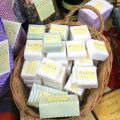
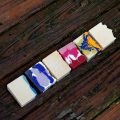
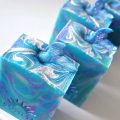
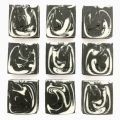
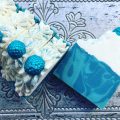
Anne-Marie, I’m not sure if you’ve heard of Play at Home Mom, but if not, you should check out their blog and FB page. I love and have had success with so many ideas and invitations to play that they’ve posted.
http://www.playathomemomllc.com
https://www.facebook.com/PlayAtHomeMomLLC
Hi Patrice!
Thanks so much for the suggestion, I will pass it along to Anne-Marie 🙂
-Amanda with Bramble Berry
; )
OMG that column swirl is AMAZING and L Love the colours!
No kidding! That’s another technique I want to try. So many options you can go with on that one. There is a guy named Sergio Masala on You Tube with a number of column pour videos, very beautiful and captivating.
Hi Odette!
I’m so glad you liked the column swirl, aren’t the colors pretty? I hope it’s a technique that you will try! 🙂
-Amanda with Bramble Berry
Michael, I’m not super experienced with soapmaking but I have a couple of suggestions based off of the things I’ve learned so far.
http://www.soapqueen.com/bath-and-body-tutorials/cold-process-soap/butterfly-swirl-soap/
That’s a great slow-trace recipe. It’s a little more than a few oils, but it’s worked well for me. I didn’t use hemp oil, and I don’t know which I put in its place but I know it was a liquid one. It may take longer to harden, but the more liquid oils you have, the slower the trace and the more time you have for designs.
I’d try to just hand stir once you’re putting fragrance in, instead of a couple of stick blend pulses. And with the colorants- try mixing it in with a tablespoon or so of a liquid oil (olive has been fine for me) before adding the soap. That way, it’ll disperse and not get chunky on you. If you get your hands on a mini frother, that’ll work really well. You can just whisk, though. Make sure your temperatures for the lye water and oil mixtures are pretty close and not too hot. I usually get both around 110 deg F. If you don’t already, try to use a lye calculator. I think a pretty common superfat is 5%. The one on the Brambleberry website is awesome!
https://www.brambleberry.com/pages/Lye-Calculator.aspx
If you don’t have some of the things in the slow trace recipe, you can play around with amounts of things you do have, as long as you use that lye calculator.
Oh, also- make sure you’re stick blending your oil mixtures before adding the lye water to ensure they’re totally mixed.
Thanks Karen! It did occur to me that I probably needed to use a lighter oil type mixture. I have checked out the lye caluclator in passing, but I’m so new I’m not trying to play with oils or create my own recipe just yet. But duh – what a great idea to check the swirl recipe on Soap Queen!
Also just a tip which I’m sure everyone knows better – my recent soap batch was made without wearing my gloves, I just forgot. Not something I recommend and I won’t forget again!
Hi Karen!
These are such great tips, thank you! Whisking in your fragrance instead of stick blending is a great one! We have also found dispersing our pigments in a light weight oil makes things a lot easier as well :). This video walks you through the process of dispersing pigments! It sounds like it’s a process you have a handle on, but you may still enjoy it :).
Learn How to Prepare Colorants for Cold Process Soapmaking:
http://www.soapqueen.com/bath-and-body-tutorials/tips-and-tricks/learn-prepare-colorants-cold-process-soap-making/
-Amanda with Bramble Berry
Can someone maybe help me with a question? I’m a very new soaper, I just today made my 4th batch of soap ever. I seem to always have a problem with my mixture immediately coming to trace. It seems like the minute the batter even sees the stick blender it accelerates. I put the stick blender in and give it a few zaps, I’m already heading to a medium to heavy trace – seriously, just a few zaps and a stir and my soap is set. Today I attempted a small in the pot swirl in my 6 inch silicone mold (from Bramble Berry YAY!). I used the basic beginner recipe of coconut/palm/olive oil and a tsp of sodium lactate. I blended just until I got emulsion and a scant trace. Then I divided out my batter into 4 containers and added a scant 1/8 tsp of powder pigment and finally added in my fragrance (lavender and herb). All of my containers accelerated dramatically and I couldn’t do my pour, I just had to plop it into the mold. Now after about 10 hours of sitting covered, it is a mossy green color on top. When I see the projects on Soap Queen the batter always seems so nice and liquid and swirly – what am I doing wrong? What recipe is good for keeping the batter managable? Thanks a lot.
FYI – I unmolded and cut my soap this morning and it has turned out to be a stunning marbled pattern. I’m very happy with it, just not what I was trying to do. The mossy green that was on the top – I guess that was my yellow color during saponification. Thanks Karen – I will try stick blending my oils too. I have also heard that it often works better to add fragrance oil in with the oils or lye water, it tends to make it more stable.
I also see those who do oils and lye at room temp – I’ve never done that – does it matter what temp you’re using as long as its below 140? So many people do it a different way and it all seems to work out.
Hi Michael,
I’m a room temperature CP soaper(for almost 6 yrs), but I only use essential oils so I can’t give you any advice on that part.
So here is my process which I learned from trial and error through the years. First, I master batch my lye- usually the day before. What that means is I make a large batch of lye/water (1:1 ratio or 50% concentrated lye). I make enough lye/water for the batches of soap I will make that day/week. This way my lye is already at room temp. You have to subtract the amount of water in the lye from your total water in your recipe. How this is done, is you need 170 g of water per pound of oils in your recipe. I usually work in 3 lb batch sizes, so one of my recipes calls for 378 g (188.8 g of lye & 188.8 g of H2O) of lye/water. I then multiply 170 X 3 = 510 g for the total water needed in my recipe. Next I subtract 188.8 g (H2O from my master batched lye/water) from 510 g (total H2O needed for the recipe) to get the extra water (or in my case goat’s milk) needed for my recipe. So it works out like this 510 – 188.8 = 321 g of water still needed when I make the soap. Then I melt my hard oils which gives them time to cool down to room temp while I get the rest of my oils, EO’s, and colors together. I don’t worry about taking the temps of my oils. I just dump them into my soap pot, mix the liquid oils in(with my stick blender to ensure they completely mixed), and once I get everything together, if my pot is cool to the touch, I know my oils are ready to go. I then give the oils a quick mix again with the stick blender, and I’m ready to go. Next I add my lye/water (the 1:1 mix) to my oils using my stick blender like a spoon(ie, I haven’t turned it on yet), then I stir in my extra water (or goat’s milk), and then I alternate using the stick blender to stir(no power) and blend (power in 10 sec burst on low). Once I get to a VERY light trace, I then add my EO’s and colors. I like to mix my colors with the colors in advance. After the colors and EO’s are mixed, I’m ready to do my swirls. This is just my process (through trial and error), and it gives me about 10 minutes to swirl my soaps. The only time I need help is when I do a rainbow column swirl soap which requires my “helper” (ie, hubby) to help me mix the colors (6) so I can get them all mixed in enough time to pour and swirl.
Based on what you wrote, I have a couple of suggestions that might help you.
1. Decrease the hard oils you are using. If you are using 33/33/33 olive, coconut, palm, your hard oils are too much (66%) of the recipe to give you time to swirl. When I’m doing a lot of swirls/patterns, I like to keep my hard oils to 30% max, which works out to 25% coconut, and 15% palm, but if I’m using my silicon BB mold, I have found I will need a higher amount of hard oils otherwise it will not release from the mold (25% each coconut and palm).
2. Decrease your oil and water temps. If you don’t want to master batch your lye/water, give it a ice bath or stick it in the fridge to give it time to cool off. Melt your hard oils 1st. As long as your oils are still liquid, they don’t need to be hot or warm.
3. Try using EO’s instead of FO’s. A lavender 40/42 EO’s is similarly priced to lavender FO’s. Although I don’t use FO’s, I’ve heard most floral FO’s accelerate trace (giving you less time to swirl). Most citrus EO’s are also very inexpensive, but make sure to get a folded one (except for lime which holds up fine in soap) like BB’s 10X orange. If you want to use FO’s, I’ve heard adding them to your oils prior to adding the lye gives you more time to work. Peppermint and spearmint are also inexpensive, but appealing EO’s choices.
A few last minute things.
Try playing around with a soap calculator. I love soapcalc.net, and use this one exclusively for my calculating my soap recipes.
I don’t think you need sodium lactate for the recipe you are using. I don’t use it, but your recipe is already really hard(49 on soapcalc.net), and the Sodium lactate may be accelerating trace.
Are you discounting your water much? When I am doing swirls, I only discount my water by 15 g per pound of oils. Using the recipe I showed above, if my extra water is 321 g, I only discounted it by 45 g, so I added 276 g of goat’s milk to my soap mixture (after I added my lye/water mix to the oils). Since you are still really new to soap making, you might be better not discounting you water at all. So you would added all 321 g of water to your recipe.
If you want to swirl, you will need to only mix to light trace, otherwise, you won’t have time to do much. After you have done enough batches to light trace, you might want to work up to mixing your batches only to emulsion. This will give you more time to swirl, but get a few more batches under your belt before you worry about that. Once you are ready, check out the lovinsoap.com blog post on 7/04/13/The patriotic peacock swirl for a great post on Emulsion vs trace. Also, canola oil great for slowing trace. I sub some of the olive oil for canola since it’s very moisturizing, and it imparts less yellow than olive(making your colors brighter). Castor oil is great for helping your soap to be very bubbly and it’s also very moisturizing. I usually have 25% coconut oil and 10% castor oil in all my recipes so I have enough bubbles without being drying to the skin. My soap was definitely better after I started using castor oil. Most soap makers use between 5-10% in their soaps.
Good luck to you in all your soapy adventures!
Heather
Thanks Heather! What great information, I will have to give this a try!
Hope it helps! 🙂
I noticed a couple of mistakes in what I wrote-that’s what happens when I try to type while my crazy kids are running around me. 🙂
1st- to give yourself time to swirl, keep your hard oils to 40% (not 30% like I originally wrote) of your recipe. I like to use 25% coconut and 15% palm.
2nd-I like to premix my colors (I use micas, activated charcoal, and oxides) with my EO’s prior to adding them to my raw soap(while my oils are cooling to room temp). Some soapers use a little bit of the water from their recipe or a tsp or olive or canola oil, but I find the EO’s work best since the recipe is already pretty soft (40% hard oils), and they colors mix better for me this way.
Heather
Hi Michael!
It looks like Heather has already provided you with a ton of great suggestions! Thanks so much Heather :). I would agree with the suggestions Heather wrote, decreasing the amount of hard oils in your recipe is a great place to start. Sometimes the fragrance you are using can also contribute to your trace (like Heather said), especially floral fragrances. On each product description, we try to provide as much info on how each oil behaves in CP, so that’s something to look for 🙂
Our Swirl Recipe Quick Mix might be something that interests you, it’s a great premixed combination of oils that is perfect for a recipe that needs swirls 🙂
Swirl Recipe Quick Mix:
https://www.brambleberry.com/Swirl-Recipe-Quick-Mix-P5526.aspx
I hope this helps, it looks like you have a lot of great suggestions to get started 🙂
-Amanda with Bramble Berry
Thanks Amanda – I really appreciate everyone’s generous advice. I do actually want to try the Swirl Mix, but its been on backorder. I know that the fragrance oil can accelerate trace or do all sorts of things to the soap mixture – I was having these acceleration problems before I even added the frangrance oil. But, I know there are several recipes on Soap Queen compatible with swirl and longer usage time, so I’ll try one of those next time perhaps too.